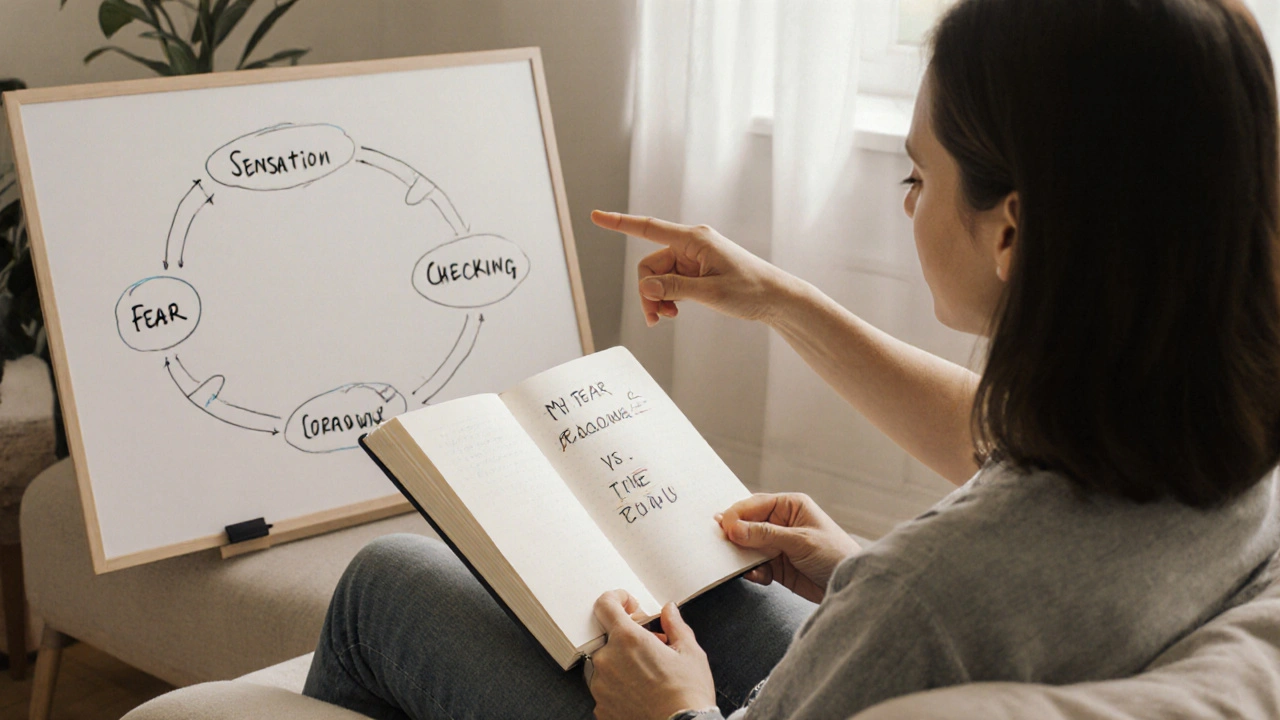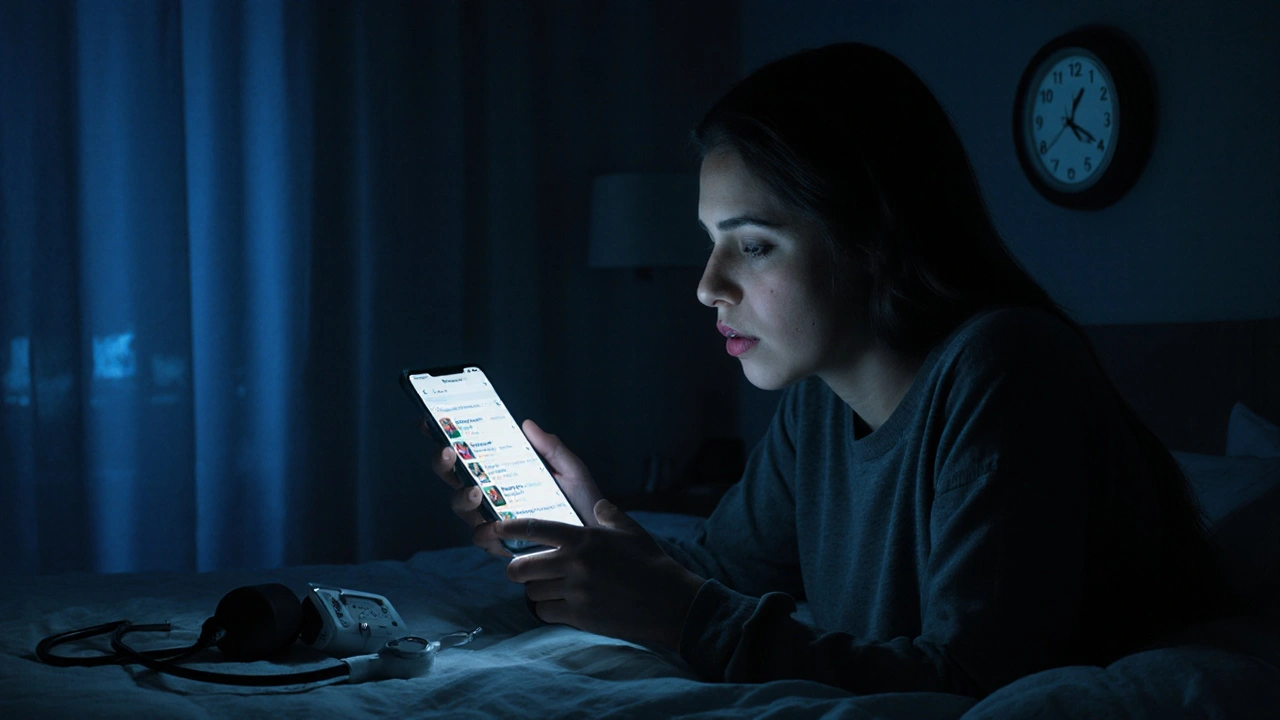Health Anxiety Assessment Tool
Take this brief assessment to better understand if your symptoms might indicate health anxiety. This is not a diagnosis, but can help guide you toward appropriate next steps.
1. How much time do you spend thinking about your health daily?
2. Have you experienced persistent health fears for six months or longer?
3. Do you avoid activities due to fear of getting sick?
4. Do you doubt negative medical test results?
5. Does your health anxiety cause problems at work, school, or in relationships?
6. Do you struggle to stop checking symptoms or Googling health information?
7. Does health anxiety prevent you from sleeping?
8. Have you stopped doing things you love because of fear?
9. Do you ask others for constant reassurance about your health?
10. Have you had a medical scare in the past that triggered ongoing fear?
Your Assessment Results
Click the button above to see your results
You check your pulse three times before breakfast. You Google every ache, every weird sensation, and end up convinced you have a rare disease. You cancel plans because your chest feels tight-even though the doctor said you’re fine. Sound familiar? You’re not alone. Health anxiety, sometimes called hypochondria, affects about 4-6% of adults. It’s not just being cautious. It’s a loop of fear, obsession, and physical tension that keeps you stuck-even when logic tells you there’s no real danger.
What health anxiety really looks like
Health anxiety isn’t about caring about your body. It’s about being trapped in a cycle where normal bodily sensations turn into signs of disaster. A headache? Brain tumor. A flutter in your chest? Heart attack. A cough? Lung cancer. The fear isn’t based on evidence-it’s based on the brain’s alarm system stuck on high.
People with health anxiety often spend hours researching symptoms online. They visit doctors repeatedly, get tests, and still don’t feel reassured. Some avoid hospitals altogether because the fear of being diagnosed is worse than the fear of illness. Others become obsessed with tracking their vitals-heart rate, temperature, blood pressure-like a human medical device.
It’s exhausting. And it doesn’t just mess with your mind. It drains your energy, ruins relationships, and keeps you from living in the present. You might miss work, skip family events, or stop going out because you’re too focused on your body to enjoy anything else.
When it crosses the line from worry to disorder
Everyone worries about their health now and then. A sore throat makes you think of strep. A missed period brings up pregnancy fears. That’s normal. Health anxiety becomes a problem when:
- You spend more than an hour a day thinking about your health
- You’ve had the same fear for six months or longer, even after medical clearance
- You avoid activities because you’re afraid of getting sick
- You’ve had multiple negative tests but still don’t believe them
- Your anxiety is causing real problems at work, school, or in relationships
These aren’t just signs-they’re red flags. If you recognize yourself in this list, you’re not being dramatic. You’re dealing with a real, treatable condition.
The physical toll of constant fear
Health anxiety doesn’t just live in your head. It shows up in your body. Chronic stress from constant worry triggers real physical reactions: muscle tension, headaches, dizziness, stomach upset, fatigue, and even chest pain. These symptoms? They’re not signs of cancer or heart disease. They’re signs your nervous system is overworked.
Studies show that people with health anxiety have higher levels of cortisol-the stress hormone-than others. Over time, this can weaken your immune system, disrupt sleep, and make you more sensitive to pain. So you feel worse, which makes you worry more, which makes you feel even worse. It’s a trap.
And here’s the cruel twist: the more you scan your body for danger, the more you notice normal sensations you used to ignore. A burp becomes a tumor. A dry throat becomes throat cancer. Your brain is trained to find threats-even when none exist.
Why going to the doctor doesn’t fix it
It’s tempting to think more tests, more opinions, more scans will bring peace. But for people with health anxiety, that rarely works. Reassurance is temporary. The relief lasts minutes, not days. Soon, a new symptom appears, and the cycle starts again.
Doctors can’t diagnose fear. They can rule out disease-but they can’t tell your brain it’s safe. In fact, repeated testing can make things worse. Each visit reinforces the idea that something is wrong. Even a clean result feels like a temporary reprieve, not a final answer.
Some people end up seeing five, six, even ten doctors over a few years. Each one says the same thing: “You’re fine.” But the fear doesn’t care what the doctor says. It only cares that you’re still feeling something. And that’s where professional help becomes essential.

When to get help-signs you’re ready
You don’t need to be broken to seek help. You just need to be tired. Here are clear signs it’s time to talk to a therapist:
- You’ve tried to stop checking symptoms or Googling, but you can’t
- You’ve lost sleep because you’re lying awake worrying about your body
- You’ve stopped doing things you love because of fear
- Your relationships are strained-you’re constantly asking for reassurance
- You’ve had a medical scare in the past, and now you’re stuck in fear mode
There’s no shame in needing help. This isn’t weakness. It’s a brain that got stuck in survival mode-and it needs rewiring.
What treatment actually works
Medication alone won’t fix health anxiety. Neither will willpower. The most effective treatment is cognitive behavioral therapy (CBT), especially a version called exposure and response prevention (ERP).
Here’s how it works: Instead of avoiding symptoms or seeking reassurance, you learn to sit with them. You stop Googling. You stop checking your pulse. You let the fear rise-and then let it pass without reacting. At first, it’s terrifying. But over time, your brain learns: the feeling isn’t dangerous. The panic isn’t a warning. It’s just noise.
Studies from the Journal of Anxiety Disorders show that 70-80% of people with health anxiety see major improvement after 12 to 16 sessions of CBT. Many report feeling like themselves again-no longer controlled by fear.
Some therapists also use mindfulness techniques to help you notice bodily sensations without reacting. Others work on reducing safety behaviors-like carrying a thermometer everywhere or refusing to go to the gym because you’re afraid of a heart attack.
What to expect in your first therapy session
Therapy doesn’t start with a diagnosis. It starts with understanding your story. Your therapist will ask: When did this start? What triggered it? What do you fear most? What do you do when you feel anxious? They won’t tell you you’re overreacting. They’ll help you see the pattern.
You’ll likely fill out a short questionnaire to measure your anxiety levels. Then you’ll start small. Maybe you’ll delay checking your symptoms by 10 minutes. Then 30. Then an hour. You’ll write down what happens when you don’t act on the fear. Slowly, you’ll build proof that you’re okay-even when you feel scared.
It’s not magic. It’s practice. And it’s powerful.
What doesn’t help-and why
Some things seem helpful but actually make health anxiety worse:
- Staring at your body in the mirror for signs of illness
- Asking friends or family for constant reassurance
- Reading medical forums or Reddit threads about symptoms
- Using apps that track your vitals obsessively
- Watching medical dramas or documentaries
These all feed the fear. They keep your brain locked in threat mode. Cutting them out is hard-but it’s the only way out.

How long does recovery take?
There’s no set timeline. Some people feel better in 8 weeks. Others take 6 months. It depends on how long the anxiety has been going, how intense it is, and how consistently you practice the skills.
Recovery isn’t about never feeling anxious again. It’s about no longer letting anxiety control your life. You’ll still notice a twinge in your side. But instead of spiraling, you’ll think: “That’s just my body. It’s fine.” And you’ll keep going.
The goal isn’t to be fearless. It’s to be free.
What you can do right now
You don’t have to wait for a therapist to start changing things. Here’s what you can try today:
- Write down your biggest health fear. Then write down the evidence for and against it. Be honest.
- Set a 15-minute daily limit on health-related searches. Use a timer.
- When you feel anxious, pause. Breathe. Ask: “Am I reacting to a feeling-or a fact?”
- Do one thing you’ve been avoiding because of fear. Walk outside. Eat a meal without checking your pulse.
- Reach out to a trusted person-not to seek reassurance, but to say: “I’m working on this. I need your support.”
Small steps add up. And they matter more than you think.
It’s not your fault
Health anxiety isn’t caused by being weak, paranoid, or overly sensitive. It’s a brain that learned to overprotect you. Maybe you had a scary illness as a kid. Maybe someone close to you died suddenly. Maybe you grew up in a household where health was constantly monitored.
You didn’t choose this. But you can change it.
You’re not broken. You’re stuck. And stuck things can be unstuck-with the right help, and the right steps.
Is health anxiety the same as hypochondria?
Yes, health anxiety is the modern term for what was once called hypochondria. The name changed to reduce stigma and better reflect how the condition works-it’s not about being delusional, but about a heightened sensitivity to bodily sensations combined with persistent fear. The DSM-5 (the diagnostic manual used by mental health professionals) now uses the term “illness anxiety disorder,” which covers both the fear of illness and the behaviors that come with it.
Can health anxiety cause real physical symptoms?
Absolutely. Anxiety triggers the body’s fight-or-flight response, which can cause real physical effects: rapid heartbeat, muscle tension, dizziness, nausea, tingling, and even chest pain. These aren’t fake-they’re physiological reactions to stress. But they’re not signs of a serious disease. They’re signs your nervous system is overactive.
Will medication help with health anxiety?
Medication isn’t the first-line treatment, but it can help in some cases. SSRIs like sertraline or escitalopram are sometimes prescribed to reduce the intensity of anxiety symptoms. But medication alone won’t break the cycle of obsessive thinking. It works best when paired with therapy, especially CBT. Think of it like a bandage-it helps with the pain, but you still need to heal the wound.
How do I find a therapist who understands health anxiety?
Look for therapists who specialize in anxiety disorders or cognitive behavioral therapy (CBT). Ask if they’ve treated illness anxiety disorder before. You can also check directories from the Anxiety and Depression Association of America (ADAA) or the Association for Behavioral and Cognitive Therapies (ABCT). Don’t be afraid to ask for a short consultation call first-it’s okay to find someone who’s a good fit.
Can health anxiety come back after treatment?
Yes, it can. Life stressors, medical changes, or major health events (like a pandemic or a loved one’s illness) can trigger a relapse. That doesn’t mean treatment failed. It means you need to use the tools you learned. Many people return to therapy for a few booster sessions when this happens. The skills you build-like tolerating uncertainty and resisting reassurance-are lifelong tools.
What comes next
You don’t have to live like this forever. Health anxiety doesn’t define you. It’s a habit your brain picked up-and habits can be changed. The first step isn’t fixing everything. It’s just deciding you’re done letting fear run your life.
Start small. Be patient. And reach out. You’ve already taken the hardest step: recognizing it’s time for change.

